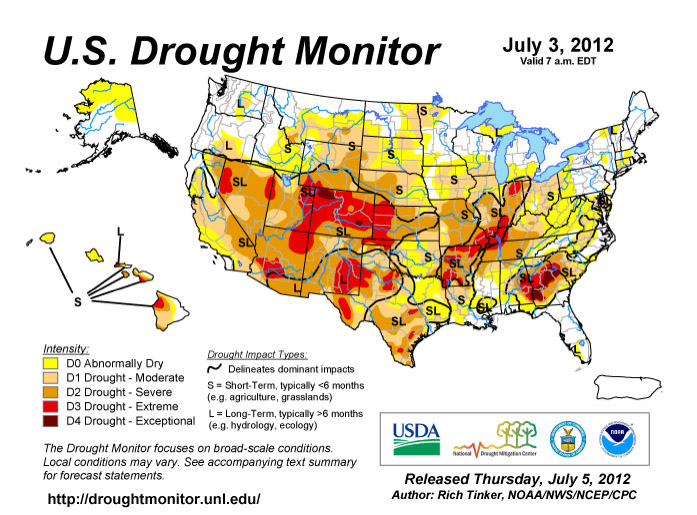Climate Photo of the Week
Huge areas of drought spread across the United States, while heat and wildfires add to climate woes.
Update to this post, 18 July 2012:
The yearly "State of the Climate" report for 2011 from NOAA and the American Meteorological Society, released July 10, shows that across the globe 2011 was cooler than 2010 because of persistent La Nina conditions, but was still in the top 15 warmest years of the 124-year measured record. But of course 2011 was the year of many extreme weather events, such as the Texas/Okahoma drought, droughts in Africa, deadly floods in Thailand and extreme heat, cold, and precipitation in Europe. A study released with the State of the Climate report, "Explaining Extreme Events from a Climate Perspective," used new analysis techniques to find that five of the six events studied, including the Texas drought, were more likely to have happened because of global warming. Scientists who were part of the study, as well as other researchers, cautioned that they are just learning how to interpret extreme events within the changing atmosphere and continuation of normal cycles like La Nina/El Nina. Overall, though, the report said:
"The accumulating body of evidence on the human contribution to changes in temperature extremes is robust, and leads to the assessment that 'it is likely that anthropogenic influences have led to warming of extreme daily minimum and maximum temperatures on the global scale' .... Heavy precipitation has been found to contribute an increasing fraction of total precipitation over many of the regions for which good instrumental records are available, indicating an intensification of precipitation extremes."
Also see an article about this report in the NY Times.
More than three quarters of the area of the lower 48 states is in drought and dry conditions, apparently the most since weekly detailed drought mapping began in 2000. The National Drought Monitor map and analysis as of July 3, by the National Drought Mitigation Center, shows areas suffering "exceptional drought" to "abnormally dry" conditions in every state except Vermont and Maine. Areas of "extreme" and "exceptional" drought range from the Four Corners in the Southwest and across most of Colorado and western Kansas, in the Ohio River valley, and across Georgia and adjoining southern states. The area affected by drought and abnormal dryness is double what it was in the blazing summer of 2011 (although less area now is in the most extreme categories experienced across the SW last year).
According to an email response from Brad Rippey of the US Department of Agriculture, it appears that "contiguous U.S. records have been set for the portion of the Lower 48 in drought.... Of course, this is a short data set, from 2000 to present." Rippey reported that this week's 76.33 percent of the lower 48 in drought beats "the former record of 71.85% ... set on July 23, 2002." Including Hawaii and Alaska, which also have dry conditions, the 50 states are more than 70 percent in drought/abnormally dry conditions now.
Over the past century heat waves and droughts were the greatest cause of death from weather events in the US. More than 15,000 people were killed in the 1980 and 1988 droughts. Until Hurricane Katrina, droughts were also the most expensive disasters. Current dryness does not yet compare with the widespread severity of droughts in the 1930s, 1950s and 1980s. Furthermore, droughts in North American pre-history were much worse: Research by scientists at Lamont Doherty Earth Observatory revealed "unprecedented megadroughts over the past millennium that clearly exceed any found in the instrumental records." North American droughts appear tied to Pacific Ocean temperatures and the ENSO cycle, which are affected by and can accentuate climate change effects. Current trends show more droughts and heatwaves are occurring worldwide.
The drought today is both a symptom of climate-driven moisture changes and a contributing cause of record elevated temperatures and wildfire. In these combined events we are seeing the kinds of effects of climate change which have long been predicted by accepted atmospheric science. Speaking on NPR on July 4, Dr. Kevin Trenberth of the climate analysis section of the National Center for Atmospheric Research, said these are the "consequences of the climate change influence that has exacerbated the drought and the heat waves." Speaking of the record high temperatures, Trenberth said, "You know, as time goes on, we always expect to set new records, but there should be an equal number of highs and lows. And in the 1950s and the '60s and '70s, that was the case. But by the time we got to the 2000s, the ratios of highs to lows was about two-to-one and this year so far it's running at about a ratio of ten-to-one. And so clearly this is just not natural variability anymore."
Thanks to scientists Richard Seager, Brad Rippey, Rich Tinker and Richard Heim for drought information.
For more analysis of the climate change effects seen in fires, heat and drought, see articles by Climate Central, Climate Communications and the New York Times.
COPYRIGHT NOTICE:
Photography and text Copyright © 2005 - 2017 (and before) Gary Braasch All rights reserved. Use of photographs in any manner without permission is prohibited by US copyright law. Photography is available for license to publications and other uses. Please contact requestinformation@worldviewofglobalwarming.org. View more of Gary Braasch's photography here.



